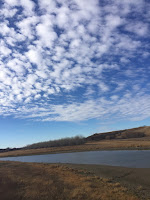 A dear friend in Berkeley sent me Facebook message one
evening saying that she felt called to go stand with the water protectors at
Standing Rock and did I want to go with her. No was never really going to be the answer, but I definitely
had to think about what I was agreeing to do. After several meetings and a week
of prep – including research, prayer, mediation, meetings, and just trying to
discern my role and reason for showing up there, I left on election night with
a group of six friends to go to the Ocheti Sakowin Camp on the bank of the
Cannonball River just outside of the Lakota Sioux Reservation at Standing Rock.
A dear friend in Berkeley sent me Facebook message one
evening saying that she felt called to go stand with the water protectors at
Standing Rock and did I want to go with her. No was never really going to be the answer, but I definitely
had to think about what I was agreeing to do. After several meetings and a week
of prep – including research, prayer, mediation, meetings, and just trying to
discern my role and reason for showing up there, I left on election night with
a group of six friends to go to the Ocheti Sakowin Camp on the bank of the
Cannonball River just outside of the Lakota Sioux Reservation at Standing Rock.
I have a deck of cards on my alter that a friend of mine in
Georgia gave me thirteen or fourteen years ago. It has images of the Buddha
from all over the world and from many lineages. I pulled a card from that deck for our trip. I pulled the only card that has no
image. It has this word,
sammasati, which means remember.
This is a portion of the dharma that goes with this word: “The last words of Gautam Buddha were
sammasati-“remember.” In a single word, everything significant is contained.
Sammasati. Remember what is your inner space. Just remember. . . Just for a few
seconds sit down with closed eyes to remember, to make a note of where you have
been, to what depth you have been able to reach: what is the taste of silence, peace? What is the taste of disappearing into
the ultimate? Look in. And
whenever you have time, you know the path. Just go again and again to the inner space so that your fear
of disappearing is dropped, and you start remembering the forgotten
language. Sammasati.
There is an exercise in Buddhist mediation practice where
two people sit together. One person simply asks the same question over and over
and the other answers it each time it is asked. The dyad is designed to pull the questioner into deep
listening and compassion. The person answering is exploring more deeply the
complexity of feeling and experiences of what is being asked. Standing Rock
felt to me like the call of this questioner and I was the one trying to
answer. I was asked over and over
during the prep to go and during my time in Standing Rock – why are you
going? Why are you going? Why are
you here? What is your intention? Why are you here? What are you doing here?
The answers are an ever-evolving response.
A friend asked me to go.
To help. NOPE!
To be in solidarity. To see my settler language and to try and decolonize my
responses.
To lament.
To be with other queer people.
To show up.
Why are you going?
To learn.
To pray.
To meditate.
To ride in a van for sixty plus hours with people I love.
To NOT get arrested.
To make phone calls, send texts, to check Facebook.
Why are you here?
To follow the water.
To sit on the ground.
To smell like campfire smoke.
To pound in tent stakes.
To hold my breath.
To wait.
Why are you here?
To chop onions.
To paint banners.
To connect to bosses, partners, friends, chosen family, moms
To meditate.
To be in ceremony.
Why are you here?
To talk to a Buddhist monk at the sacred fire.
To stand for the first half of the pipe ceremony with the
women and for the second half with the men.
To hear the elders call for Two Spirit Nation to take their
place at the water ceremony.
To smell sage.
To cry.
To have no words.
Why are you here?
To not know.
To not understand.
To hold stories and songs in my heart that were a gift to
hear and to know that they are NOT my gift to give.
Why are you here?
To learn that Two Spirit is not just a beautiful way of
saying LBGTQ.
To NOT see burned out cars, barricades, or militarized
police.
To see community.
To see peace -
not to bring it.
To join prayers – not to create them.
To live into story – not narrate it.
To learn from elders and follow their lead
Zubian,
a two spirit elder, said to me: “
I have been transformed before. Others
are here for that transformation.”
He was speaking of a young woman who
had pulled him out of the way of a speeding truck meant to hit him and stop
him from praying at a direct action. But it was clear he meant more than just
her.
Why did you go?
To follow the water.
To sleep on the ground, listening to the calls of prayer,
and drums, and drones, and helicopters, and wind, and flags.
Why did you go?
To shout Mni Wiconi and mean it.
Why did you go?
To protect.
To have hope.
To be surprised.
To remember.































